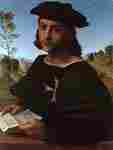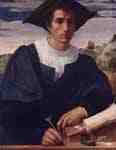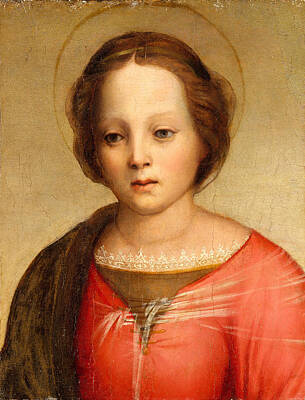
Portrait of a Knight of Rhodes

Portrait of a young man at his desk
----
Fine Art Prints | Greeting Cards | Phone Cases | Lifestyle | Face Masks | Men's , Women' Apparel | Home Decor | jigsaw puzzles | Notebooks | Tapestries | ...
----
Franciabigio (1482 – January 24, 1525) was an Italian painter of the Florentine Renaissance. His true name may have been Francesco di Cristofano, however he also is referred to as either Marcantonio Franciabigio or Francia Bigio.
Life and career
Madonna con Bambino, san Giuseppe e san Giovannino or Madonna of the Well or Madonna and Child with the young St. John the Baptist
He was born in Florence, and initially worked under Albertinelli until about 1506. In 1505 he befriended Andrea del Sarto; and by the next year, the two painters set up common shop in the Piazza del Grano. He was proficient in fresco and Vasari claimed that he surpassed all his contemporaries in this method. It's in his portraits, and not his religious paintings and frescoes, that his painting gathers naturalistic power.
In 1513, in the cloister of the Annunziata he frescoed the Marriage of the Virgin, part of a larger series mainly directed by Andrea del Sarto, and overshadowed by the latter's masterpiece of Birth of the Virgin.[1] Other artists working under Sarto at the cloister included Rosso Fiorentino, Pontormo, Francesco Indaco, and Baccio Bandinelli.[2]
In 1514, he frescoed a Mategnesque Last Supper for the Convento della Calza in Florence.[3] In 1518-19, at the Convento della Salzo, in another series of frescoes on which Andrea was likewise employed, he executed the Departure of John the Baptist for the Desert, and the Meeting of the Baptist with Jesus.
In 1520-21, at the villa Medici at Poggio a Caiano he frescoed a turgid Triumph of Cicero on the walls of the salon, but again he is overshadowed by Potormo's naturalistic lunette of Vertumnus and Pomona. The array of figures appears distraught rather than celebratory, the antique details are a melange of quotations, and the architect a fancy of Quattrocento style.[4] He painted a St Job altarpiece (1516, Uffizi).
In the early 1520s, Franciabigio also painted Madonna and Christ Child, a composition that highlights Raphael Sanzio's influence. Scholars note this painting's significance in illustrating naturalism.[5]
Various works which have been ascribed to Raphael are reasonably deemed to be by Franciabigio. Such as the Madonna del Pozzo, with its awkwardly muscular John the Baptist;[6] and some of his portraits, including the half figure of a Young Man. These two works show a close analogy in style to another in the Pitti gallery, avowedly by Franciabigio, a Youth at a Window, and to some others—which bear this painter's recognized monogram.
The series of portraits, taken collectively, placed beyond dispute the eminent and idiosyncratic genius of the master. Two other works of his, of some celebrity, are the Calumny of Apelles, in the Pitti Palace, and the Bath of Bathsheba (painted in 1523), in the Dresden gallery.
Critical assessment and legacy
When compared to his younger contemporary colleague, del Sarto, Franciabigio appears more sculptural and less forward-looking. The Quattrocento monumentality (or stiffness) of posing is evident in figures. Franciabigio attends more to linearity and balance in fresco recalling Massacio, while the complexity and Sarto's paintings reflect an understanding of the dissipating velvety colorful fabric of molding that characterizes Venetian work, and the development of sway that will "mannerize" art in the decades to come.
Footnotes
According to Vasari, the friars having uncovered this work before it was quite finished, Franciabigio was so incensed that, seizing a mason's hammer, he struck at the head of the Virgin, and some other heads; and the fresco, which would otherwise be his masterpiece in that method, remains thus mutilated
Betrothal of Virgin at Annunziata cloister.
Last Supper at Convento della Calza
Triumph of Cicero at Poggio a Caiano.
Birmingham Museum of Art (2010). Birmingham Museum of Art : guide to the collection. [Birmingham, Ala]: Birmingham Museum of Art. p. 157. ISBN 978-1-904832-77-5.
Madonna del Pozzo at the Uffizi Gallery.
References
Freedberg, Sydney J. (1993). Pelican History of Art, ed. Painting in Italy, 1500-1600. Penguin Books. pp. 96–97.
Attribution
This article incorporates text from a publication now in the public domain: Chisholm, Hugh, ed. (1911). "Franciabigio". Encyclopædia Britannica. 10 (11th ed.). Cambridge University Press. p. 933.
Artist
A - B - C - D - E - F - G - H - I - J - K - L - M -
N - O - P - Q - R - S - T - U - V - W - X - Y - Z
Retrieved from "http://en.wikipedia.org/"
All text is available under the terms of the GNU Free Documentation License



